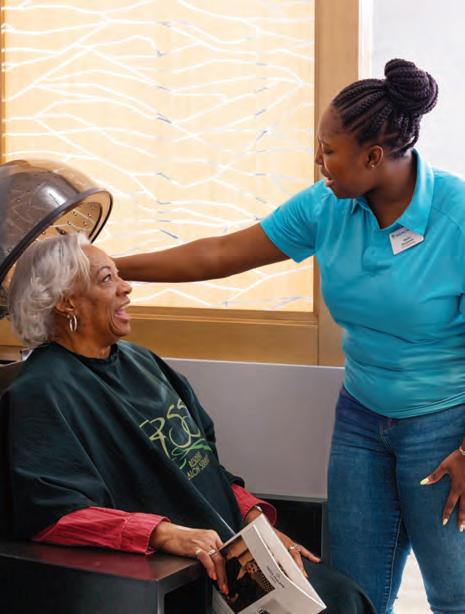



Staying Connected in Retirement page 3
Navigating Medicare Options page 4
Balancing Grandparenting Roles page 7










Staying Connected in Retirement page 3
Navigating Medicare Options page 4
Balancing Grandparenting Roles page 7





Learn how different technology tools can help you and your loved ones enjoy life’s greatest moments together — even while you’re apart.
BY LEILA BEN ABDALLAH
Entering retirement opens the door to a world of excitement and new experiences. However, it can also bring challenges, particularly when it comes to staying connected with family and friends. Many new retirees often find themselves grappling with feelings of isolation and loneliness, which are completely normal during this transition. In a 2023 poll from the American Medical Association, roughly 37 percent of US adults aged 50-80 reported experiencing loneliness.
The good news is a 2023 study published in Information, Communication & Society found that regular communication through technology — such as calling, texting, and interaction through other digital platforms — can significantly alleviate these feelings. Here are some ways you can stay connected with loved ones using different technological tools, many of which are just a tap away on your phone.
Tips for staying connected
1. Use texting and calling to keep in touch regularly
Phone calls and texts are simple but powerful ways to keep your family and friends close, even when they’re miles away. If you’re new to these tools or need a refresher, don’t worry: getting started is easy.
FaceTime allows you to reach your loved ones instantly and chat face-to-face, just as you would in person. Simply open the app (it looks like a bright green square with a white camcorder), select “New FaceTime,” and select whomever you’d like to talk to as if you were making a call. If you want to keep a consistent routine, try scheduling weekly calls with family and friends and use your phone’s calendar app to set reminders so you never miss a catch-up session.
and enjoy the show with a chat panel on the side that will open once your invitees have joined the watch party.
For grandparents, apps like Readeo allow you to select a bedtime story and read it to your grandchildren over the phone, meaning you never have to miss this cherished part of the day together. Another app called Marco Polo lets you send and receive recorded messages if you’re unable to connect with your loved ones at a specific time.
3. Share and relive special moments together
Sharing memories isn’t limited to in-the-moment updates — there are plenty of ways to look back on special moments and preserve them for everyone to enjoy.
Start by creating a shared photo album with your family and friends through Google Photos or iCloud, so everyone can upload pictures from trips, events, or everyday moments. If you want to take it a step further, you can even use apps like Locket to place live photos from loved ones directly on your phone’s home screen. That way, every time someone in your circle sends a new picture, it’ll appear instantly, so the people you care about are never far from view.
FaceTime allows you to reach your loved ones instantly and chat face-to-face, just as you would in person.
Sending a quick text or sharing photos of your day is another great way to give loved ones a glimpse into your life. Explore apps like WhatsApp or your phone’s built-in messenger app to send text, photos, or videos.
2. Make virtual activities part of your routine
There are also plenty of ways to engage in fun activities together using technology.
Many streaming services have “teleparty” extensions that allow you to select a show or movie and send a link to a friend or family member so you can watch them together simultaneously. You can even use a built-in chat panel to send your thoughts, reactions, and predictions in real time.
Some streaming platforms like Hulu already have this feature built in. Simply select what movie or show you’d like to watch, and select the “Watch Party” button right next to the “Watch Now” button you would click if watching solo. The platform will generate a link that you can text or email to a family member. After sending the link, you can go back to the streaming platform
Finding and downloading the right apps
Now that you’ve explored various ways to stay connected, the next step is to equip yourself with the right tools. You can visit your smartphone’s app store to search for any of the apps you saw in this article. Whether you’re using an iPhone or Android device, here’s how to find and install them with ease.
How to access the app store
On an iPhone, look for the App Store icon — it’s a blue square with a white “A.” On an Android, you’ll find the Google Play Store, represented by a gray icon with a colorful triangle.
• Open the app Store: Tap the icon to open the store.
• Search for apps: Once inside, find the search bar (usually at the top or bottom of the screen). Tap the magnifying glass icon and type the name of the app you’re looking for, like FaceTime, WhatsApp, or Google Photos.
• Download apps: When you find the app, tap “Get,” “Download,” or the cloud icon. You may need to enter your Apple ID password or use Face ID for confirmation.
• Open and use: After downloading, tap “Open” to launch the app, or find it on your home screen for easy access later.
With a little curiosity and practice, you’ll discover that staying connected is simpler and more rewarding than ever. Remember, the key to a fulfilling retirement lies not just in the activities you pursue, but in the relationships you nurture.

BY TUFTS HEALTH PLAN, A POINT32HEALTH COMPANY
Navigating Medicare options for the first time can be confusing. Even for those who have had employer-offered or individual health plans for decades, Medicare comes with its own set of plan options and requirements. So how can you make an informed decision and select a plan that’s best for you and your health needs? Start with the basics and get answers to some of Medicare’s most common questions.
When should I start the process of applying for Medicare?
The timeline for applying for Medicare coverage can depend on a variety of factors, so let’s look at a few common scenarios:
You are nearing 65 and ready to switch to Medicare
For those interested in enrolling in Medicare around their 65th birthday, there is a seven-month period to enroll called an Initial Enrollment Period. The timing for this is different for everyone, as it begins three months before the enrollee turns 65 and ends three months after the month they turn 65. To be sure of when you’ll become eligible, Medicare.gov offers an eligibility calculator.
You are nearing or above 65 but have an employer-sponsored health plan
So maybe you’re eligible for Medicare, but you (or your spouse) are still on an employer-sponsored health plan. If it’s preferred to keep the employer plan until you and/or your spouse are retired, that is an option. When you’re ready to retire, you’ll be able to participate in a Special Enrollment Period without any late penalty. Aside from an employer-sponsored health plan, there are also some other situations that will qualify you for a Special Enrollment Period.
You’re 65 (or older) but missed the Initial and Special Enrollment Periods
Each year between January 1 and March 31, you can enroll during the Open Enrollment Period. However, should you apply after the seven-month Initial Enrollment Period and aren’t enrolling as part of a Special Enrollment Period, you may have to pay a monthly late enroll-
ment penalty for as long as you have Part B (and sometimes for Part A) coverage. The same can apply if you have Part A and Part B coverage but opt to sign up for Part D coverage later.
A common misconception about Medicare is that since your tax money pays into Social Security and therefore Medicare, you are automatically enrolled once turning 65. This is not accurate. Regardless of when you choose to get Medicare coverage, you’ll need to apply for and enroll in it yourself.
What are the different Parts of Medicare?
Medicare coverage is broken down into four Parts:
Part A is part of Original Medicare, which is offered by the Federal Government. Most people don’t pay a monthly premium for Part A, but there is a deductible.
Part A provides coverage for hospital visits such as inpatient hospital stays or hospice care, provided the facility accepts Medicare.
Part B, also part of Original Medicare offered by the Federal Government, provides coverage for medical services. Typically, a Part B premium is deducted from your Social Security payments upon enrollment, although you may receive a bill every three months if you don’t receive Social Security. Part B provides coverage for medical services such as an annual physical or a medically necessary ambulance ride.
Part C is additional coverage offered by private health insurance companies, also known as Medicare Advantage plans. Part C covers all the benefits of Original Medicare (Part A and Part B), plus additional benefits that Original Medicare doesn’t cover. Many people choose to add Part C because it provides more complete coverage than just Original Medicare. Part C is not required, but if you choose to get it, you must also have Part A and Part B (Original Medicare). Part C offers coverage for additional benefits such as routine eye exams, dental, and prescription drug coverage (available with many, but not all, Part C plans).
Part D is prescription drug coverage. This can be included with a Part C plan or pur-
chased separately through private health insurers. Like Part C, Part D is not required with Medicare, but if you choose
Regardless of when you choose to get Medicare coverage, you’ll need to apply for and enroll in it yourself.
to add it, you must also have Original Medicare. Part D covers a variety of prescription drugs.
What choices do I have for Medicare plans?
Anyone enrolling into a Medicare plan must first choose Original Medicare: Original Medicare, which comes from the Federal Government, includes Part A and Part B. It’s important to remember that Original Medicare only covers approximately 80 percent of Part B expenses, leaving the remaining amount as your responsibility.
Because of this, there are gaps in your coverage when relying only on Original Medicare. For example, Original Medicare has deductibles and does not have a limit on out-of-pocket spending. It also does not cover Part D prescription drugs, routine vision and hearing exams, and other services. Those enrolling in Original Medicare have plan options through private health insurers to consider for additional coverage, as many find that Original Medicare on its own does not provide enough coverage. Two options to consider are a Medicare Advantage plan and a Medicare Supplement plan: A Medicare Advantage plan (Part C) will cover everything that Original Medicare covers, as well as additional benefits. Medicare Advantage plans, which come from a private health insurer, typically have lower monthly premiums than Medicare Supplement plans and are often available with prescription drug coverage (Part D), which allows you to have medical and drug coverage all in one plan.
Then there’s the option for a Medicare Supplement plan, which can cover gaps in Original Medicare. Typically, Medicare Supplement plans have higher monthly premiums than Medicare Advantage continued on next page

plans, but you can see any doctor who accepts Medicare. If prescription drug coverage is needed, you would need to purchase a separate prescription drug plan (PDP), Part D, as it’s not included with a Medicare Supplement plan.
4
Is it better to keep my employer’s health insurance or get Medicare?
As mentioned earlier, you do have the option to keep your employer’s health insurance even if you are of Medicare age. The best choice will depend on your current job, lifestyle, and health care needs.
For instance, if you work for a company with more than 20 employees, you might choose to sign up for Medicare Part A coverage if there’s no premium for you. In that case, your job-based insurance
pays first, followed by Medicare. For those who work for an employer with less than 20 employees, you’ll want to ask your employer if you’ll need to sign up for Medicare Part A and Part B upon turning 65. And for those who have health insurance from Medicaid or Marketplace, whether you need to sign up for Medicare will depend on what your current health plan covers and if you anticipate needing additional coverage for the next year.
5 How do I choose the right plan for me?
Choosing health insurance of any kind is a personal decision, one that depends on your health, age and lifestyle. For Medicare, consider these factors when deciding what works best for you: Your Health
How often do you visit a doctor, specialist, or hospital? If you are in good health,
a plan with a $0 or low monthly premium might be best. If you see your doctor more often, you may want a plan with a higher monthly premium in exchange for lower doctor visit copays.
Your Budget
Consider whether you want to pay less each month or less when you visit a doctor. Typically, there are lower monthly premiums with Medicare Advantage versus a Medicare Supplement plan, but fewer services require a copayment with a Medicare Supplement plan. Another consideration is out-of-pocket costs.
Medicare Advantage plans provide an out-of-pocket maximum that limits the amount you spend on medical costs in a year, but with Original Medicare and Medicare Supplement plans, there is no annual limit to how much you may have to pay out of pocket.









Your Doctors and Specialists
Choosing a Medicare Advantage health maintenance organization (HMO) plan means you have a primary care physician (PCP) who works together with a team of specialists to help you stay healthy and get the care that is right for you, whereas a Medicare Advantage preferred provider organization (PPO) plan means you can see any doctor but are responsible for coordinating your own care. With a Medicare Supplement plan, you don’t have a PCP, but you can see any doctor who accepts Original Medicare.
Drug Coverage
With a Medicare Advantage plan, you can have Part D prescription drug coverage and medical coverage all in the same plan. With a Medicare Supplement plan, if you want prescription drug coverage, you’d need to enroll in a separate prescription drug plan (PDP).
While some of the most common questions regarding Medicare have been addressed here, this is by no means an exhaustive list, and there are additional resources available to support you through the Medicare enrollment process. Medicare.gov, for example, offers a ZIP code breakdown that outlines health plan options available for you with an estimated cost.

























With millions of grandparents raising their grandchildren, the challenges are immense, but so are the rewards.

BY CATHIE ERICSON
Taking charge of her three grandchildren — who were ages 5, 4, and 3 at the time — was supposed to be a temporary two-week respite when Kim Rockwood of Webster, Mass., stepped up as a caregiver in November 2017. By July 2018, she became their legal guardian, and today she continues to oversee their health, schooling, and well-being.
Rockwood is hardly alone as the trend of grandparents raising grandchildren becomes more prevalent. According to national data from the Department of Labor, nearly 3 million children were being raised by a grandparent as of 2021. The US Census Bureau found that grandparents were also more likely to be responsible for their grandchildren for five years or longer in 2021 compared to 2012.
Stepping into the role of a grandparent as caregiver
Raising grandchildren comes with a whirlwind of emotions, from frustration to fatigue to fulfillment.
While Rockwood is proud of her role, the emotional toll can still set in when she reflects on the sacrifices she’s made — including putting off pursuing her master’s degree after being accepted at Boston College. Today she works in health services administration and provides in-home health care on off-hours. While the kids are in school, she’s working; when they go to sleep, she’s working. And, of course, raising a child as a 58-year-old is different than when she was 25, especially in today’s world. “I’m someone who calls, rather than using email and text. But today, that’s how everyone communicates,” Rockwood says. “It took a while to realize that lots of things were going by me.”
She has found the hardest part to be the never-ending need to champion her grandchildren’s best interests. “When I first started, I didn’t know how to access services and didn’t realize what was out there. I didn’t even know what or who to ask,” she says. As a way to help others in her situation, she hosts a “Grandparents Raising Grandchildren” support group on the second Wednesday of each month.
The shift in retirement
Raising grandchildren can also be a parttime job, performed to help parents fill budgetary gaps created by the skyrocketing cost of childcare. According to a 2024 report from nonprofit Child Care Aware of America, caring for two children now costs more than the average rent in all 50 states. A Harris poll found that “four in five working families that rely on grandma to provide childcare said they’d be ‘lost’ without this support.”
Angela O’Neil, a licensed independent clinical social worker (LICSW) with Thriveworks in Leominster, Mass., has seen an increase in both types of caregiving — raising grandchildren full time and helping ease the burden on working families.
“While parents feel relief knowing a family member is providing care, it also can be beneficial to the grandparent,” O’Neil says. “Older adults enjoy helping their loved ones, but they also are able to create a different type of relationship with their grandkids by being present. The children feel nurtured and are able to bond with the grandparent in a special way.”
In addition, providing part-time care can benefit retirees who may find they have missed the structure and purpose they found in their work. “Making this positive impact on family can help them find a sense of belonging and meaning,” says O’Neil.
Real world advice for grandparents as caregivers
While kinship care can be a rewarding experience for everyone, it also involves a big lifestyle change — and a lot of emotions. Here are some ways to navigate common challenges and optimize everyone’s well-being.
1. Set boundaries
When stepping in to provide part-time care as a grandparent, it’s critical to be open about what you can realistically undertake. “Find out the expectations and communicate your availability from the start,” O’Neil says. She recommends creating a written contract you can revisit as time goes on and circumstances change.
When you’re in a situation where you have a choice, she points out that it doesn’t need to be all or nothing. “Be clear about what you can commit to.
According to national data from the Department of Labor, nearly 3 million children were being raised by a grandparent as of 2021.
If watching them five days a week sounds like too much, would two or three feel feasible?”
2. Manage energy levels
There’s no doubt that exuberant kids can be exhausting. Don’t neglect yourself — take the time to eat well, get plenty of sleep, and stay physically active to maintain stamina. O’Neil suggests exercise as an effective solution for improving health, as well as stress management and mood improvement.
Some Medicare programs cover free online classes from SilverSneakers that can be taken remotely or at a gym. O’Neil also points to the YMCA of Greater Boston’s Healthy Habits program and the Massachusetts Council on Aging website, which offer a variety of exercise classes and social engagement programs. Local senior centers also often host a menu of
options for staying physically, mentally, and socially healthy.
3. Aim for balance to maintain a fulfilling retirement
Caregiving should just be one aspect of a healthy retirement, says O’Neil, who recommends seniors set both short-term and long-term goals. “Schedule in your commitments, but also take the time you need for hobbies, volunteering, and travel,” she says.
Once again, she promotes balance and advises looking into community resources, such as senior centers for events and engagement, as well as community colleges, which often provide a tuition waiver for people ages 60 and above.
“Focus on yourself as a whole and getting your physical, emotional, social, intellectual, and spiritual needs met,” she says.
“When you feel your best, you can give your best.”
You don’t have to go it alone
Full-time caregiving is much different than a more flexible grandparenting role, and Rockwood knows how overwhelming it can feel. The top piece of advice she offers is to ask for help.
“No one can do it alone,” she says.
“Your grandchildren are the ones who will suffer if you can’t admit you need help.”
Once Rockwood began seeking guidance, things started to fall into place as she became aware of more resources, from camp scholarships to food assistance.
A few opportunities to look into include:
• Kinship Navigator, designed to help caregivers in Massachusetts find supportive services
• PPAL, which provides mental health support for grandparents and kids
• The Commission on the Status of Grandparents Raising Grandchildren of Massachusetts, which offers support groups and resources
• Parenting a Second Time Around (PASTA), a free support group for grandparents provided by the New Hampshire Kinship Navigators
As any parent knows — whether you’re doing it the first or second time — the days are long, but there is always joy in the small things.
“I’ll be in my car and turn the radio on, and if the kids had been watching a DVD while we were driving, a movie will come on, and I smile,” says Rockwood. “It’s a part of my life I never thought I’d have.”












